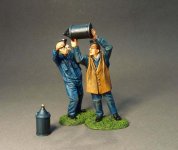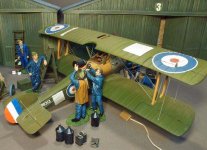KNIGHTS OF THE SKIES
**PLEASE NOTE THIS SET IS SPECIFICALLY DESIGNED TO BE USED WITH THE SOPWITH CAMEL AEROPLANE**

BGC-16
KNIGHTS OF THE SKIES
“Refuelling The Camel”,
(3pcs)
By early 1917 the British Shell company had a complete monopoly on the supply of aviation fuel to both the British and French armed forces.They also controlled the distribution of gasoline in France via the 'pool' system in which petrol companies 'pooled' their gasoline in Britain for transport by Shell tankers to ports across the channel in France, where the Shell company then established canning centres for the onward supply of gasoline in jerry cans to British and French military forces.
They maintained this monopoly until the end of 1917, when the arrival of the US forces brought their own gasoline supply network and for the first time gasoline pumps to replace cans. But Shell aviation fuel was so ubiquitous by this time that contemporary British references to aviation fuel of this period are often made just to "Shell A" (the 'A', presumably, for 'Aviation' or 'Aircraft').
The Sopwith Camel shot down 1,294 enemy aircraft during World War I, more than any other Allied fighter. However, it was so difficult to fly that more men lost their lives while learning to fly it than using it in combat. A total of 5,490 Camels were built.
The pilot, engine, armament and controls were all crammed into a seven-foot space at the front of the airplane. This gave the plane a phenomenal performance, but it also made the plane very tricky to fly. Additionally, the plane’s wood and fabric construction and lack of protection for the fuel tank made the Camel (like most WWI aircraft) very susceptible to fire. Moreover, the poor state of pilot training during 1916-1917 meant that the average life expectancy of an English pilot was little more than two weeks.
The Sopwith Camel needed a very specific fuel mixture.

FOR FURTHER INFORMATION, PRICES AND AVAILABILITY, PLEASE CONTACT YOUR REGULAR DEALER.
**PLEASE NOTE THIS SET IS SPECIFICALLY DESIGNED TO BE USED WITH THE SOPWITH CAMEL AEROPLANE**

BGC-16
KNIGHTS OF THE SKIES
“Refuelling The Camel”,
(3pcs)
By early 1917 the British Shell company had a complete monopoly on the supply of aviation fuel to both the British and French armed forces.They also controlled the distribution of gasoline in France via the 'pool' system in which petrol companies 'pooled' their gasoline in Britain for transport by Shell tankers to ports across the channel in France, where the Shell company then established canning centres for the onward supply of gasoline in jerry cans to British and French military forces.
They maintained this monopoly until the end of 1917, when the arrival of the US forces brought their own gasoline supply network and for the first time gasoline pumps to replace cans. But Shell aviation fuel was so ubiquitous by this time that contemporary British references to aviation fuel of this period are often made just to "Shell A" (the 'A', presumably, for 'Aviation' or 'Aircraft').
The Sopwith Camel shot down 1,294 enemy aircraft during World War I, more than any other Allied fighter. However, it was so difficult to fly that more men lost their lives while learning to fly it than using it in combat. A total of 5,490 Camels were built.
The pilot, engine, armament and controls were all crammed into a seven-foot space at the front of the airplane. This gave the plane a phenomenal performance, but it also made the plane very tricky to fly. Additionally, the plane’s wood and fabric construction and lack of protection for the fuel tank made the Camel (like most WWI aircraft) very susceptible to fire. Moreover, the poor state of pilot training during 1916-1917 meant that the average life expectancy of an English pilot was little more than two weeks.
The Sopwith Camel needed a very specific fuel mixture.

FOR FURTHER INFORMATION, PRICES AND AVAILABILITY, PLEASE CONTACT YOUR REGULAR DEALER.
Last edited:

